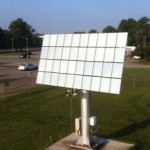New Record for High Concentration Phovoltaic Solar Modules
 A new record has been set by the high concentration photovoltaic (HCPV) solar module industry. A module made by Semprius, a company in which Siemens invested as a strategic partner in June 2011, reached 33.9 percent, breaking the previous record of 32 per cent. The module was tested by the Instituto de Energía Solar at the Universidad Politécnica de Madrid (IES-UPM). This efficiency result was certified by the IES-UPM and corroborated by outdoor measurements made at the Institute of Concentration Photovoltaic Systems (ISFOC) in Puertollano, Spain.
A new record has been set by the high concentration photovoltaic (HCPV) solar module industry. A module made by Semprius, a company in which Siemens invested as a strategic partner in June 2011, reached 33.9 percent, breaking the previous record of 32 per cent. The module was tested by the Instituto de Energía Solar at the Universidad Politécnica de Madrid (IES-UPM). This efficiency result was certified by the IES-UPM and corroborated by outdoor measurements made at the Institute of Concentration Photovoltaic Systems (ISFOC) in Puertollano, Spain.“This is a significant milestone for Semprius and the entire PV industry,” said Scott Burroughs, vice president of Technology at Semprius. “For the first time, we have been able to convert more than one-third of the sun’s energy into usable electricity. This demonstrates how concentrated PV can leverage rapidly increasing efficiencies to continue driving down the cost of solar generated electricity.”
Semprius’ HCPV module design begins with its proprietary micro-transfer printing process. This process enables the company to fabricate the world’s smallest solar cell (approximately the size of a pencil point) to create solar modules with high efficiency and performance.
“This is the culmination of our emphasis on bringing smart design to solar,” said Joe Carr, chief executive officer of Semprius. “We looked carefully at each component of our module – cell, optics, enclosure and the manufacturing process – to develop a competitive solution that embodies high efficiency, performance and reliability.”
After developing its module with the support of the U.S. Department of Energy’s National Renewable Energy Laboratory, Semprius is now ramping up global deployment of demonstration systems while completing construction of a pilot plant in Henderson, North Carolina. Commercial production at the plant will begin during the second half of 2012
You can return to the main Market News page, or press the Back button on your browser.

